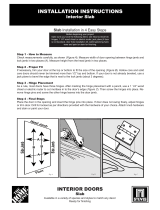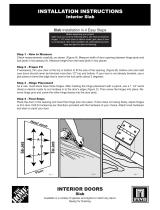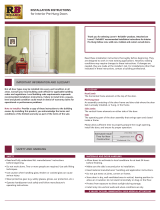
INSTALLATION INSTRUCTIONS
for Interior Door Slabs
1
Consult your local building code ofcial for applicable building
codes and regulations. Local building code requirements supersede
recommended installation instructions.
Note to Installer: Provide a copy of these instructions to the building
owner. By installing this product, you acknowledge the terms and
conditions of the limited warranty as part of the terms of the sale.
Thank you for selecting Lowe’s
®
ReliaBilt
®
products. Attached are
Lowe’s
®
ReliaBilt
®
recommended installation instructions for all
types of wood Interior door slabs including molded, ush, custom
carved and stile and rail. Read these instructions thoroughly
before beginning. They are designed to work in most existing
applications however; existing conditions may require changes
to these instructions. If changes are needed, they are made at
the installer’s risk. For installations other than indicated in these
instructions, contact a building professional.
IMPORTANT INFORMATION AND GLOSSARY
GLOSSARY
Head Jamb
The horizontal jamb across the top of the opening.
Hinge
Metal component that attaches the slab to the jamb and allows the slab
to swing open and closed.
Hinge Jamb
The side jamb the hinges are mounted in.
Hinge Leaves
The at parts of the hinge that mount to the jamb and slab.
Hinge Pin
Pin that holds the hinge leaves together and allows them to pivot.
Hinge Route
Mortise in the jamb and slab the same prole as the corresponding
hinge leaf.
Jambs
Framework attached to the structure that the slab is mounted to, or
hung in.
Panel
Component of the slab lling the spaces between the stiles and rails.
Estimated Install
Time for New
Construction
First Time: 1.5 hr.
Experienced: 0.75
Professional: 0.5 hr.
1
2
3
4
5
6
7
8
9
10
11
12
Please allow sufcient time to properly prepare the opening, install the
slab, and ensure its proper operation.
SAFETY
• Read and fully understand ALL manufacturers’ instructions
before beginning.
• Do not work alone. Two or more people are recommended. Use safe
lifting techniques.
• Use caution when handling glass. Broken or cracked glass can cause
serious injury.
• Wear protective gear (e.g. safety glasses, gloves, ear protection, etc.).
• Operate hand/power tools safely and follow manufacturer’s
operating instructions.
IF INJURY OCCURS, IMMEDIATELY SEEK MEDICAL ATTENTION!
MATERIALS AND SLAB HANDLING
• Allow doors to acclimate for at least 24 hours to local conditions
before installation or nishing.
• Store slabs in a dry, well-ventilated protected area off of the oor.
Buildings where humidity and temperature are controlled provide the
best storage facilities (recommended conditions 30%-50% Relative
Humidity and 50°F to 90°F)
• Protect from exposure to direct sunlight during storage.
• Handle doors with clean hands or while wearing clean gloves.
• Lift and carry doors to move, do not drag across one another.
• Heed material manufacturers’ handling and application instructions.
• Install only into vertical walls and when conditions are dry.
Pilot Hole
A drilled hole that is no larger than the body of the screw (minus the
threads).
Rail
Horizontal members of the door slab.
Slab
The operating part of the door assembly that swings open and closed
inside a frame.
Stile
Vertical members of the door slab.
Stop
Component xed to the inside the jamb that the slab closes against.
Strike Jamb
The side jamb that contains the latch strike to hold the slab closed.
SAFETY AND HANDLING

INSTALLATION INSTRUCTIONS
for Interior Door Slabs
2
1
2
3
REMOVE PACKAGING AND INSPECT SLAB
INSPECT EXISTING JAMB
INSTALL SLAB
NEEDED MATERIALS AND TOOLS
• Existing jamb should be
3/16" wider than the
slab and at least 3/8"
taller. There should
be enough distance
between the jamb
edge and the stop
to accommodate the
thickness of the slab.
• Verify the existing
jamb is square. The (A)
and (B) measurements
should be the same.
Maximum allowable
deviation from square
is 1/4".
• Verify the existing jamb is level and plumb (C) and (D). The maximum
allowable deviation is 1/8".
• The opening oor or sill must be at and level (not be crowned or
sagged) (D).
• The face of the rough opening must be in a single plane (E) with less
than 1/8" twist from corner to corner.
Do not install the slab unless the jamb meets the above conditions.
Professional assistance may be necessary to correct any problems before
installation.
• Remove shipping materials such as corner covers, shipping blocks
or pads.
• Inspect slab for cosmetic damage, squareness and warp
• Verify it is the correct product (size, color, design, handing etc.)
If any of the above conditions represent a concern, do not install the
slab. Contact the supplier for recommendations.
NEEDED MATERIALS
Note! Follow all material manufacturers’ instructions for proper use
and compatibility.
• Hinges
• Wood screws: 3/4" minimum through hinges into the slab and frame;
For solid core, custom carved and stile and rail doors, 1 - 2 1/2"
through each of the top two hinges into framing
• Wood putty/spackle
• Lockset and template
• Finishing supplies
• Masking tape (for trimming)
• 150-280 grit sandpaper
NEEDED TOOLS
• Safety glasses
• Screwdrivers
• Pencil
• Chisel or router
• Drill with bits and hole saws
• Tape measure
• Level
• Finishing tools (paint brushes,
roller, spray equipment, masking
tape etc.)
• Circular saw (for trimming)
• Wood plane (for trimming or
beveling)
• Hammer
• Punch
IMPORTANT: The door slab should be nished (painted or stained) on
all six sides with an equal number of coats after all routing, trimming,
boring and touch-up has been completed and it has been properly t
in the jamb. Note! If hinges are already installed on the slab, do not
remove hinges for nishing.
Failure to nish on all six sides and install into a square, level
and plumb condition could result in denial of warranty claims for
operational or performance problems.
PREPARE JAMBS AND SLAB
1. Measure the existing
frame (not the stop)
from oor to head
and from side to side
in several places to
verify the slab will t.
The frame should be
3/16" wider than the
slab (1/16" clearance
on the hinge jamb and
1/8" clearance on the
strike jamb) and tall
enough (usually
1/4" - 1/2" taller) to
allow 1/8" clearance on the head jamb and allow the slab to operate
without rubbing on any ooring.
A
B
D
C
E
Verify
Square,
Level, &
Plumb
Frame
Stop

INSTALLATION INSTRUCTIONS
for Interior Door Slabs
3
3
INSTALL SLAB - CONTINUED
2. If necessary to t
the existing jamb,
a maximum of 1/4"
can be trimmed
from each side of
hollow or solid
core molded and
fush doors only.
Trimming any
other type is not
recommend. For the
best appearance,
trim an equal
amount from
opposite sides. To
minimize chipping,
stick masking tape
along the cut line
to each face of the
slab. Make the cuts
with a ne toothed
circular saw (height)
and wood plane
(width). Trimming
beveled edges may
require re-beveling.
3. The latch stile may
have a pre-cut 2˚ or
3˚ bevel. This bevel
maintains a 1/8"
clearance between
the jamb and latch
edge and improve
the t when the
slab is closed. If
the latch stile is
not beveled, and a
bevel is preferred,
use a wood plane or
ne-toothed saw to
cut a bevel so that
the slab face that rests against the stop becomes slightly narrower
than the opposite face.
TEST SLAB FIT IN JAMBS
Before installing any
hardware, t the
slab in the frame
and verify it will t
properly. Looking at
the hinge side of the
slab when it is closed,
there should be 1/16"
gap between the
slab and hinge jamb
and1/8" between the
slab and the head and
strike jamb.
Bottom
rail
Stile
1/4"
1/4"
1/4"
Top rail
Trim-able
portion
Trim-able
portion
Slab
Bevel
Stop
1/16"
1/8"
1/8"
INSTALL HINGES
1. Three hinges are recommended for slabs up to 84" in height and four
hinges for slabs over 84".
2. If re-using existing
jambs, verify the
existing hinge
locations are plumb,
or all in a straight line
vertically. Position
the new hinges in the
existing locations and
modify the mortises
as necessary. Match
the slab to the jambs
using the following
instructions.
3. If installing new
jambs, measure down
from the underside of
the top of the jamb
7" to position the
top of the top hinge.
Measure up from the
bottom of the slab 10"
to position the bottom
of the bottom hinge.
Place the middle hinge
halfway in between.
4. When marking the
slab for hinges, make sure the measurement from the top of the slab
to the top of the hinge route is 1/8"smaller than the distance from
the head jamb to the top of the top hinge. This will allow 1/8" gap
between the slab and head jamb.
5. When marking the
slab, the distance from
the inside face to the
back of the hinge
route should be 1/16"
less than the depth of
the hinge route on the
jamb.
6. Using a template,
mark the jambs and
slab where the hinges
will be mounted.
Using a chisel or
router, notch the jamb
and slab for the outline of the hinge leaves and no deeper than the
thickness of the leaves.
7. Using the hinge as a template, mark screw hole locations and drill
pilot holes for all screws. If possible, it may be easier to remove the
hinge pin to separate the hinge leaves. Use a hammer and a punch to
drive the pin from the open end. Install the hinge leaves separately
on the jambs and slab (we recommend using a hand screwdriver
when installing screws into the slab to prevent stripping). Then, hang
the slab in the frame by aligning the hinge leaves and re-install the
hinge pins.
6 7/8"
7"
Plumb
line
3/16"
1/4"
Slab
Hinge
jamb
Stop

Ask about Lowe’s installation services.
Learn more at lowes.com/installation.
©2014 Lowe’s Companies, Inc. All rights reserved. Lowe’s, the gable design and
Never Stop Improving are trademarks of LF, LLC. All are used with permission.
4
INSTALLATION INSTRUCTIONS
for Interior Door Slabs
(03/14)
JII110-Lowes
4
COMPLETE INSTALLATION
INSTALL LOCKSET AND FINISH INSTALLATION
1. The center of the
hole for the lockset is
usually 44" from the
top of the slab and
either 2 3/8" or
2 3/4" on center from
the edge, depending
on the latch. For
slabs that have
a rail (horizontal
member) across the
center of the slab,
the lockset should
be centered in this
rail. Using the lockset
manufacturer’s
instructions and template, drill for lockset. Generally, a 2 1/8"
diameter hole is needed for the lockset. Drill a 1" latch hole through
the edge of the slab into the center of the lock hole to accommodate
the latch for the lock. Some latches have a radius (rounded corners)
or rectangular face plate that will require the slab edge to be
chiseled for t. Drill pilot holes for attachment screws. Other latches
are round (contractor drive-in) and can be tapped into place with a
hammer.
2. Close slab and check for proper operation. Adjust as necessary.
3. Finish all surfaces of the slab if not already done.
4. If installing a solid
core, custom carved,
or stile and rail slab,
install a #9 x 2 1/2"
screw in the center
hole (as shown) in
the top two hinges
(through the leaves
toward the jamb).
Lockset
hole
Rail
Panel
Latch
hole
2 3/8"
Jamb
Replace with
longer screw
-
 1
1
-
 2
2
-
 3
3
-
 4
4
JELD-WEN LOWOLJW137000286 Installation guide
- Type
- Installation guide
- This manual is also suitable for
Ask a question and I''ll find the answer in the document
Finding information in a document is now easier with AI
Related papers
-
JELD-WEN THDJW222200679 Installation guide
-
JELD-WEN THDJW136501053 Installation guide
-
JELD-WEN JW227300008 Installation guide
-
Unbranded A01660 Installation guide
-
JELD-WEN JW227700001 Installation guide
-
Woodgrain 218720.0 User manual
-
Woodgrain RB225400308 Installation guide
-
JELD-WEN THDJW225101059 Operating instructions
-
JELD-WEN 218720.0 Installation guide
-
Woodgrain THDJW221100070 User manual
Other documents
-
Krosswood Doors PHED.KA.405V.28.80.134.LH.Clear Installation guide
-
Shimpo SR-3050 User manual
-
Steves & Sons TWFG-3679-FLN-SLB Installation guide
-
 Steves & Sons M64NPNNNAC99 Operating instructions
Steves & Sons M64NPNNNAC99 Operating instructions
-
 Steves & Sons PIN909028 Installation guide
Steves & Sons PIN909028 Installation guide
-
Steves & Sons J64NZNNNAC99 Installation guide
-
GREENWOOD LOA2496MJA-RH User manual
-
Trim-A-Slab 3080 User guide
-
ReliaBilt 10760 User guide
-
 Woodgrain JW103800023NK Installation guide
Woodgrain JW103800023NK Installation guide






